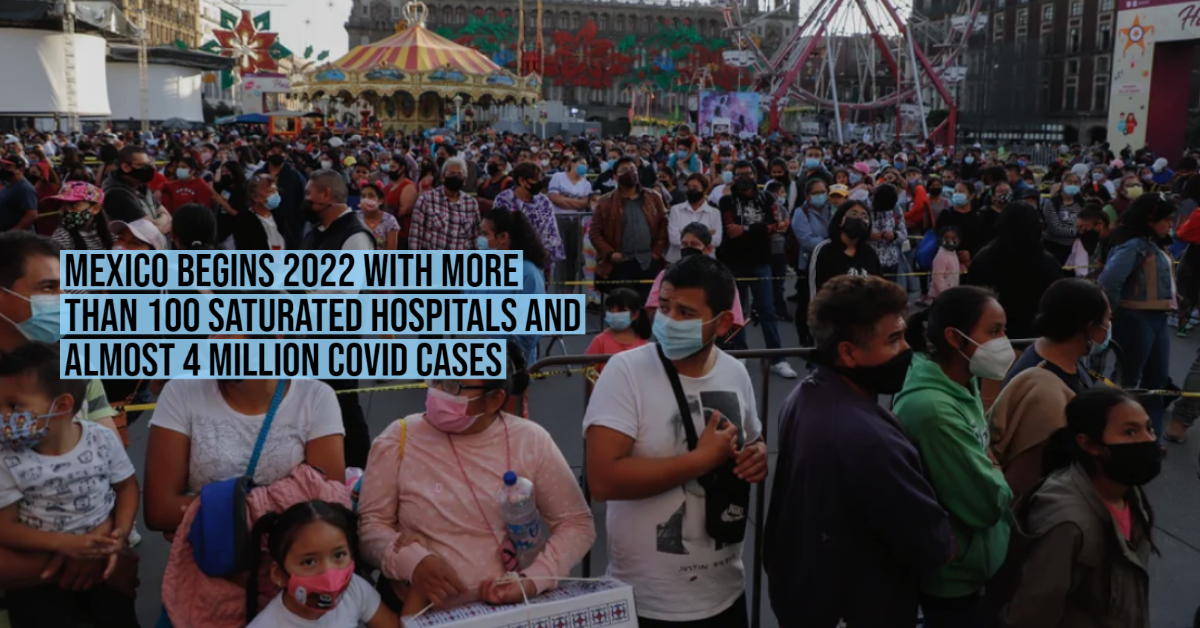Mexico began 2022 in the face of a new wave of COVID-19 infections. According to the latest official figures, the country almost exceeds 4 million accumulated cases since the beginning of the pandemic, in the midst of a new wave that is expected to get worse after holiday celebrations.
In the last week, the numbers of cases broke records that have not been seen for months: on Monday, December 27, there were 943 positives; the following day 4,426 were confirmed; on Wednesday, 5,290; On Thursday, 8,024 were counted and on Friday —the last day of the year— the largest number of cases in the last three months was reported: 10,037 infected people for a total of 3,979,723 accumulated cases since the health emergency began.
Specialists believe that the Delta variant will begin to decrease and Ómicron, much more contagious, will become the predominant one in Mexico in January; For now, according to data from the global initiative for sequencing the virus Global Initiative on Sharing All Influenza Data ( GISAID ), dated December 29, in national territory the number of people infected with the Omicron variant is 254.
It was on December 25 when the platform that collaborates with the World Health Organization ( WHO ) reported that 42 cases of the new variant of COVID-19 were registered in the country, of which 30 were found in Mexico City ( CDMX ), eight in the State of Mexico ( Edomex ), three in Tamaulipas and one in Sinaloa.
In just five days the cases reported by GISAID soared, as the platform in charge of collecting clinical and epidemiological data announced that of the 254 infections with Ómicron, 159 are in the capital and 35 in Edomex; while Quintana Roo and Yucatán have 18 and 13 cases, respectively.
Other states where cases with the new variant were registered according to GISAID are Tabasco, Tamaulipas, Puebla, Sinaloa, Chiapas, Hidalgo, Veracruz, Baja California, and Guerrero, although the government of Guerrero ruled out the existence of Omicron cases.
According to the Mexican Consortium for Genomic Surveillance – a computer site that analyzes the variants of COVID-19 that circulate in the country – Delta continues to be the predominant one in Mexico; However, Ómicron is already beginning to enter different entities, mainly in the Northeast Region (Coahuila, Nuevo León, and Tamaulipas) and in the South Central Region (Hidalgo, Puebla, Tlaxcala, Morelos, Edomex and CDMX).
The Information System of the IRAG Network, of the Ministry of Health, reported that 85 hospitals are above 70% in their general bed areas to care for patients with complications from COVID-19; another 14 hospitals are above this percentage in their intensive care areas; while in the occupancy of beds with ICU ventilators, 19 hospitals are saturated. Altogether there are 118 hospitals considered saturated, 18 more than in the previous week.
The database of the country’s hospital system reports that these hospitals, which are at their maximum capacity, are distributed in 25 entities.
According to the most recent report, dated December 31, among which there is no capacity to receive more patients in general beds are La Raza, Hospital General Ajusco Medio, several units of the IMSS in Mexico City, the hospital of Los Reyes La Paz, Molinito and Metepec in the State of Mexico.
This list includes the Regional Hospital in Guadalajara, the Mazatlán Hospital in Sinaloa, the Gómez Palacio, Durango; and Félix U. Gómez in Nuevo León.
Mexico began 2022 in the face of a new wave of COVID-19 infections. According to the latest official figures, the country almost exceeds . . .












